PEP小学英语六年级下册英语教案
六年级英语人教PEP版下册Unit2_B_Read_and_write名师教案

5.教师请学生第二次细读文段第一段,然后回答问题:What was the room like?
6.教师请学生第三次阅读文段,要求学生小组合作,阅读文段其他部分,找出Mike的爸妈以及Mike的困扰是什么,然后完成文段后Find the sentences that describe Picture 1-3部分。
2.能根据阅读所获取的信息完成填充邮件的活动,巩固所学句型。
四、重难点预设
1.重点:能够读懂本部分短文并完成文后练习。
2.难点:能够提高阅读技巧,掌握基本阅读策略。
五、评价设计
1.通过直观看图、点名提问等活动检测目标1的达成情况;
2.通过小组合作、讨论、点名提问等活动检测目标2的达成情况。
六、教学设计
2.Revision
请学生拿出上节课布置的调查表作业,简单介绍自己的同伴在过去的时间所做的事情。
呈现新课
(Presentation)
Read and write
1.T: Do you know housekeeper?教师边说边呈现单词housekeeper.然后继续说What can they do? Who can tell me?鼓励学生畅所欲言。教师帮助学生理解housekeeper:A housekeeper is a person whose job is to cook, clean and look after a house for its owner.
第5课时
教学环节
教学预设
热身/复习(Warm-up/Revision)
PEP人教版小学英语六年级下册英语教案全册

4.话题:本册涵盖了日常生活、兴趣爱好、季节天气、节日活动等话题。
三、教学重点与难点
1.教学重点:
掌握本册所学词汇、短语和句型。
能够熟练运用所学知识进行日常交流。
培养学生的英语听说读写能力。
2.教学难点:
不同时态的运用。
句型的转换。
词汇的记忆与运用。
四、教学策略
1.情境教学法:通过创设情境,让学生在实际语境中学习英语,提高学生的语言运用能力。
2.任务型教学法:以任务为中心,引导学生积极参与,培养学生的自主学习能力。
3.合作学习法:鼓励学生进行小组合作,培养学生的团队协作能力。
4.个性化教学法:关注学生的个体差异,因材施教,提高学生的学习兴趣。
Unit1“Howtallareyou?”
对话示例:
K:"Wheredidyougoonvacation?"
L:"Iwenttothemountns.Itwasbeautiful!"
Unit4“Who'syourfavoriteanimal?”
重点难点使用一般现在时描述喜好。
教学过程补充:
活动一:学生制作小卡片,上面画上自己喜欢的动物,然后互相交流。
对话示例:
C:"Howtallisyourbrother?"
D:"Mybrotheris180centimeterstall."
Unit2“Whattimeisit?”
重点难点:掌握时间表达法,能够准确询问和回答时间。
教学过程补充:
活动一:利用挂钟或电子钟,教师任意调整时间,让学生用“Whattimeisit?”进行问答。
人民教育出版社小学英语PEP教材六年级下册

人民教育出版社小学英语PEP教材六年级下册Unit 1 My day (the 5th period)【教学简案】第5课时【教学详案】课前预习:1.预习听读教材P 8 Let's learn。
2.预习已学有关活动的词组,如:play sports, play basketball, play ping-pong, sing English song等。
教学内容:Unit 1 My day B Let's learn & Do a survey教学目标:1. 能够能听、说、读、写四个有关日常活动的词组:clean my room, go for a walk, go shopping, take a dancing class。
2. 能够在语境中正确运用以上四个词组描述日常活动。
3. 能够完成调查及填表活动并根据结果展开问答。
教学重点:掌握并运用Let’s learn部分四会短语,并运用What do you do on the weekend?句型进行问答。
教学难点:掌握always, often, sometimes, usually频率副词的用法。
教学用具:1.多媒体课件 2. 板书贴条教学过程:一、Warming up1. Sing a song:My weekend2. Let’s say:根据歌曲视频,引出Mike’s weekend和Pedro’s weekend,让学生看图片谈一谈。
T: In the video, we sang about Pedro and Mike’s weekend. Look at this picture. If you are Mike, can you talk about his weekend?S: I often clean my room on the weekend. (板书often)S: I sometimes go shopping on the weekend. (板书sometimes)T: What about Pedro’s weekend?(指着Pedro的图片提问)S: I usually play football and play basketball on the weekend.(板书usually)T: Right. We can also say Pedro usually plays sports on the weekend.设计意图:歌曲活跃课堂气氛,营造轻松学习氛围,吸引学生的注意力,为学生学习课文词组和语言表达做铺垫;以歌曲中人物活动作为引子,帮助学生回顾所唱的内容,为后面学习相关周末活动做铺垫;其次,运用图片中的星级标注引出3个频率副词,将抽象内容具体化,有助于学生对虚词的理解。
PEP人教版小学英语六年级下册英语教案(全册)
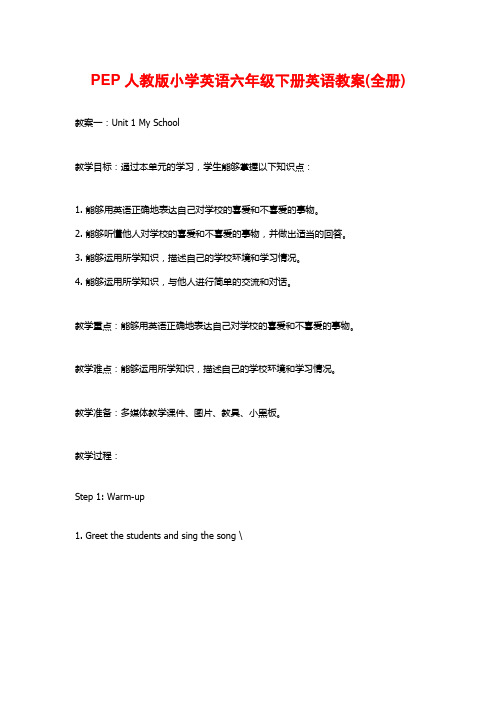
PEP人教版小学英语六年级下册英语教案(全册) 教案一:Unit 1 My School
教学目标:通过本单元的学习,学生能够掌握以下知识点:
1. 能够用英语正确地表达自己对学校的喜爱和不喜爱的事物。
2. 能够听懂他人对学校的喜爱和不喜爱的事物,并做出适当的回答。
3. 能够运用所学知识,描述自己的学校环境和学习情况。
4. 能够运用所学知识,与他人进行简单的交流和对话。
教学重点:能够用英语正确地表达自己对学校的喜爱和不喜爱的事物。
教学难点:能够运用所学知识,描述自己的学校环境和学习情况。
教学准备:多媒体教学课件、图片、教具、小黑板。
教学过程:
Step 1: Warm-up
1. Greet the students and sing the song \。
人教PEP六年级下册英语《Unit 2 Last weekend PartB Read and write》教案
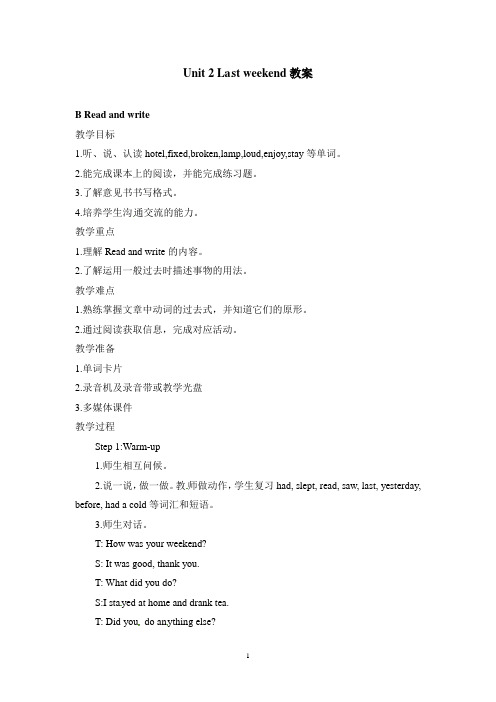
Unit 2 Last weekend教案B Read and write教学目标1.听、说、认读hotel,fixed,broken,lamp,loud,enjoy,stay等单词。
2.能完成课本上的阅读,并能完成练习题。
3.了解意见书书写格式。
4.培养学生沟通交流的能力。
教学重点1.理解Read and write的内容。
2.了解运用一般过去时描述事物的用法。
教学难点1.熟练掌握文章中动词的过去式,并知道它们的原形。
2.通过阅读获取信息,完成对应活动。
教学准备1.单词卡片2.录音机及录音带或教学光盘3.多媒体课件教学过程Step 1:Warm-up1.师生相互问候。
2.说一说,做一做。
教师做动作,学生复习had, slept, read, saw, last, yesterday, before, had a cold等词汇和短语。
3.师生对话。
T: How was your weekend?S: It was good, thank you.T: What did you do?S:I sta yed at home and drank tea.T: Did you do an ything else?S: Yes,I cleaned my room and washed my clothes.Step 2:Presentation1.阅读前。
(1)教师提问学生是否住过酒店,引出单词hot el,并通过图片分别展示好的与差的酒店。
请学生回忆曾经去过的印象较深的酒店是什么样子,能在酒店里做什么,和大家分享在酒店里遇到的愉快的或者不愉快的事情。
(2)教师在课件上呈现Mrs Broom的头像,向学生介绍:Mrs Broom works ina hotel.She is a housekeeper. What did she do yesterday?请学生选择:made the beds,cooked the food,cleaned the rooms等短语。
PEP小学英语六年级下册Unit3单元整体教学设计

PEP小学英语六年级下册Unit3单元整体教学设计PEP小学英语六年级下册Unit3单元整体教学设计一、教学目标知识与技能:1.掌握表示颜色的单词。
2.学习表达“穿”衣服的动词。
3.了解并掌握一些常见的穿衣搭配。
情感态度与价值观:1.培养学生的团队合作意识。
2.让学生学会感恩生活,并感受到彼此之间的爱与关爱。
二、教学重点掌握表示颜色的单词,学习表达“穿”衣服的动词。
三、教学难点了解并掌握一些常见的穿衣搭配。
四、教学内容1. 核心词汇:yellow, green, blue, black, white, yellow pants, blue shirt, green cap, black shoes, white socks, wear, clothes。
2. 重点句式:I’m wearing a green cap and black shoes.She is wearing a blue shirt and yellow pants.What color is your cap?What are you wearing today?五、教学方法采用任务式教学法,学生在团队合作的情境中完成任务,让学生在情景中理解单词和句型的含义并能够流利使用。
同时采用游戏、歌曲、口语交际等多种教学方式,丰富教学内容,提高课堂趣味性。
六、教学流程Step 1:Warm-up开场播放Let's learn一课关于颜色的学习flash,学生跟读,复习颜色词汇。
Step 2:Presentation and practice1. Presentation(1)Teacher wears different clothes and ask students to make sentences in the form of "I'm wearing...". For example, teacher wears a red hat and green shoes, then teacher says "I'm wearing a red hat and green shoes", then ask students to repeat. And helps students to learn the phrase “I’m wearing...”。
新版PEP小学六年级英语下册Unit-3-Where-did-you-go教案

Unit 3 Where did you go ?第一课时What can you do ? I can dance.What can you do ? I can climb a mountain.What can you do ? I can take a pictures.What can you do ? I can speak Chinese.2.用多媒体课件展示自己外出旅游的照片, 并做相关介绍。
如:s.summe.holiday..wen.t.hainan.I.wa.s.beautiful..wen.swimmin.i.th. sea.An.picke.som.seashell.o.th.beach.Ste.2.PresentationLet’s talk(从呈现完整对话到处理局部语言)1.整体感知对话并回答问题。
(1)通过提问要求学生猜测: Did yougo to John’s home ? What happened toJohn? What did they talk about later?请学生带着问题观看动画或阅读文本, 了解John脚受伤的原因: He fell of hisbike,利用图片帮助学生理解并教授fell.同时, 通过观看动画或阅读文本获得对话的主旨: They talked about John’s Labout Day holiday...(2)结合日历,让学生理解Labou.Da.holiday概念。
提问: Loo.a.th.calendar.Wha.dat.i.i..It’.Ma.1s..O.Ma.1s.,uall.hav.thre.day.ofbou.Da.holiday.(3)继续提问学生:Where did John go on his Labour Day holiday ? What did hedo there ? 要求学生带着问题观看动画或阅读文本获取信息, 并用思维导图板书对话关键信息。
人教PEP版六年级英语下册《Unit1-A-Let’s-talk名师教案》
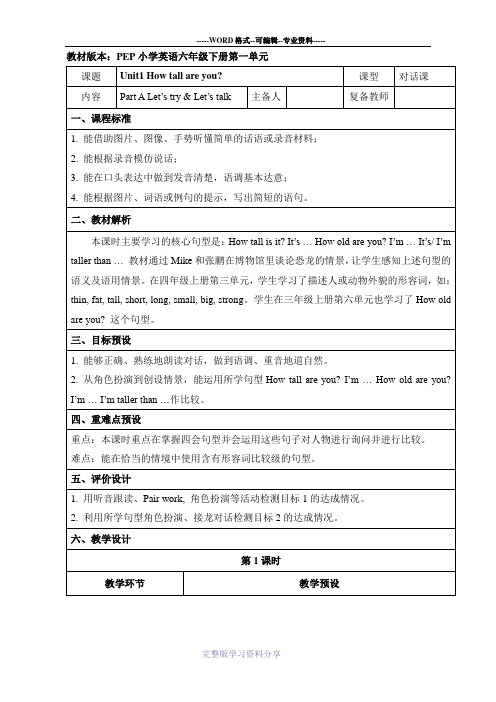
3.核对答案,呈现一高一矮两只恐龙的图片,并提问:Can you guess which one is the second dinosaur? Yes, because this one is taller.帮助学生理解taller的含义。
Let’s talk
1.课件呈现博物馆图片,引导学生用It’s tall/strong …描述图中的恐龙,复习巩固已学形容词。
难点:能在恰当的情境中使用含有形容词比较级的句型。
五、评价设计
1.用听音跟读、Pair work,角色扮演等活动检测成情况。
六、教学设计
第1课时
教学环节
教学预设
热身/复习(Warm-up/Revision)
1. Sing a song: “At the zoo”.
采访你的同学,询问他的身高和年龄,与你作比较,并将你们的对话写下来,不少于4句话。
七、板书设计:
Unit1 How tall are you?
dinosaur, hall, metre, than, taller, tallest
That’s the tallest dinosaur in this hall.
2. Group work
根据实际情况,完成课文下面的填空,并展示。
(先将自己的信息补充完整,然后在小组内询问并找到比自己高、比自己大的同学,将句子写在问句后的横线上,最后在组内展示。)
3.打开U1 A Let’s talk课堂基础练/拔高练,即学即练,检测当堂学习情况。
小结
(Summary)
1.Read the talk together.
作业设计
(Homework)
新人教版pep小学六年级下册英语教案全册
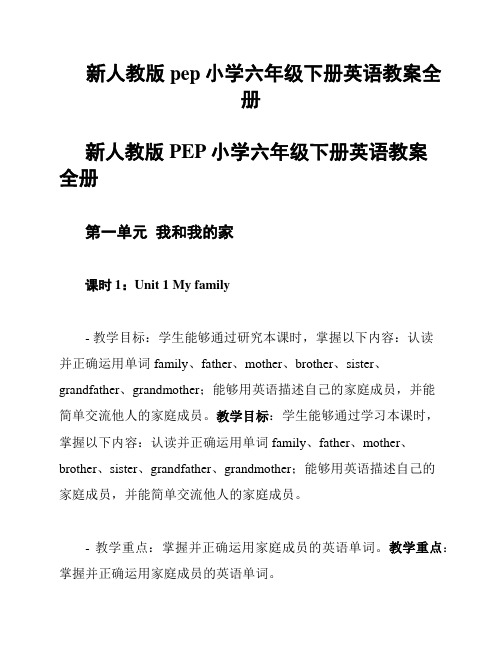
新人教版pep小学六年级下册英语教案全册新人教版PEP小学六年级下册英语教案全册第一单元我和我的家课时1:Unit 1 My family- 教学目标:学生能够通过研究本课时,掌握以下内容:认读并正确运用单词family、father、mother、brother、sister、grandfather、grandmother;能够用英语描述自己的家庭成员,并能简单交流他人的家庭成员。
教学目标:学生能够通过学习本课时,掌握以下内容:认读并正确运用单词family、father、mother、brother、sister、grandfather、grandmother;能够用英语描述自己的家庭成员,并能简单交流他人的家庭成员。
- 教学重点:掌握并正确运用家庭成员的英语单词。
教学重点:掌握并正确运用家庭成员的英语单词。
- 教学难点:用英语描述家庭成员。
教学难点:用英语描述家庭成员。
- 教学准备:PPT、单词卡片、家庭成员图片、练册。
教学准备:PPT、单词卡片、家庭成员图片、练习册。
- 教学过程:教学过程:1. 导入新课:呈现家庭成员图片,让学生说出英语单词并尽量运用在句子中。
2. 研究新知:教师通过PPT呈现单词卡片,将家庭成员单词分别与对应的图片进行呈现,学生跟读并重复。
3. 听说训练:通过描述家庭成员的图片开始练说英语。
教师提问,学生回答,并给予相应的鼓励。
4. 听力训练:播放录音,学生听录音并指认家庭成员。
5. 巩固练:练册上的相关练。
- 作业:完成练册上的相关练。
作业:完成练习册上的相关练习。
- 板书设计:板书设计:- Unit 1 My family- father- mother- brother- sister- grandfather- grandmother课时2:Unit 2 My home- 教学目标:学生能够通过研究本课时,掌握以下内容:认读并正确运用单词home、bedroom、living room、kitchen、bathroom;能够用英语描述自己的家庭住所,并能简单交流他人的家庭住所。
PEP小学六年级英语下册教案全册及反思

Unit 1 How tall are you ?第1课时教学内容:P2Let’s start and chant, P4Let’s learn and Let’s play.一、教学目标与要求1、能够听、说、认读本课时的主要词组:taller stronger older youngershorter。
2、能认读句型:How tall are you ?I’m 164cm.You’re shorter thanme. You’re 4cm taller than me .二、教学重点与难点1、重点掌握形容词比较级的构成。
2、难点是对新句型 How tall are you ?I’m 164cm.You’re shorter than me. You’re 4cm taller than me .的理解和运用。
三、课前准备1、教师准备本课时所需的六张词卡。
2、教师准备录音机和录音带。
3、教师准备本单元的挂图。
四、教学过程1、Warm-up(1)教师在黑板上贴上一些人物的图像,让学生分辨Who is tall /strong/old/young/short?,然后让学生回答。
2、Presentation and practicelet’s learn(1)教师指着比较高的Tom和比较矮的Wuyifan问Who is tall ?S:Tom.T:Tom is taller than Wuyifan ,用动作来示意学生,帮助学生理解。
然后出示taller的单词卡片,示范读taller.(2)教学单词taller,边说边做动作,学生跟做。
开火车合拼单词,小组比赛快速熟练的拼读。
帮助学生用tall+er来记忆。
简单介绍形容词的比较级第一种情况是在形容词的后面直接加“er”.本课时的几个单词都属于这种变化。
(3)教师用同样的方法教学其他四个四会单词stronger older younger shorter(4)将五张单词卡放在一起请学生认读。
PEP小学英语六年级下册全册教案
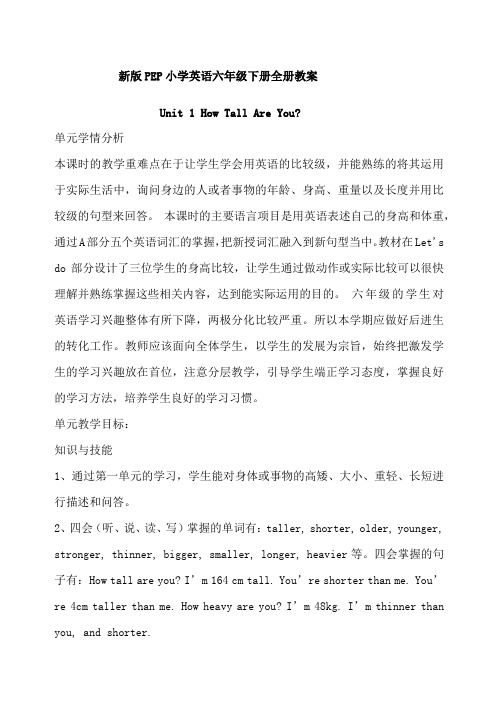
新版PEP小学英语六年级下册全册教案Unit 1 How Tall Are You?单元学情分析本课时的教学重难点在于让学生学会用英语的比较级,并能熟练的将其运用于实际生活中,询问身边的人或者事物的年龄、身高、重量以及长度并用比较级的句型来回答。
本课时的主要语言项目是用英语表述自己的身高和体重,通过A部分五个英语词汇的掌握,把新授词汇融入到新句型当中。
教材在Let's do部分设计了三位学生的身高比较,让学生通过做动作或实际比较可以很快理解并熟练掌握这些相关内容,达到能实际运用的目的。
六年级的学生对英语学习兴趣整体有所下降,两极分化比较严重。
所以本学期应做好后进生的转化工作。
教师应该面向全体学生,以学生的发展为宗旨,始终把激发学生的学习兴趣放在首位,注意分层教学,引导学生端正学习态度,掌握良好的学习方法,培养学生良好的学习习惯。
单元教学目标:知识与技能1、通过第一单元的学习,学生能对身体或事物的高矮、大小、重轻、长短进行描述和问答。
2、四会(听、说、读、写)掌握的单词有:taller, shorter, older, younger, stronger, thinner, bigger, smaller, longer, heavier等。
四会掌握的句子有:How tall are you? I’m 164 cm tall. You’re shorter than me. You’re 4cm taller than me. How heavy are you? I’m 48kg. I’m thinner than you, and shorter.3、能够运用计量单位kg和m,能根据所给的数据,运用比较词than进行事物或身体的比较或描述。
课时教学设计课题:Unit 1 (第1课时)教学目标:知识与能力:1、能听、说、读、写taller、longer、older、younger 、shorter,than 单词,发音准确。
Unit 1 How Tall Are you?Part B教案-人教(pep)版小学英语六年级下册
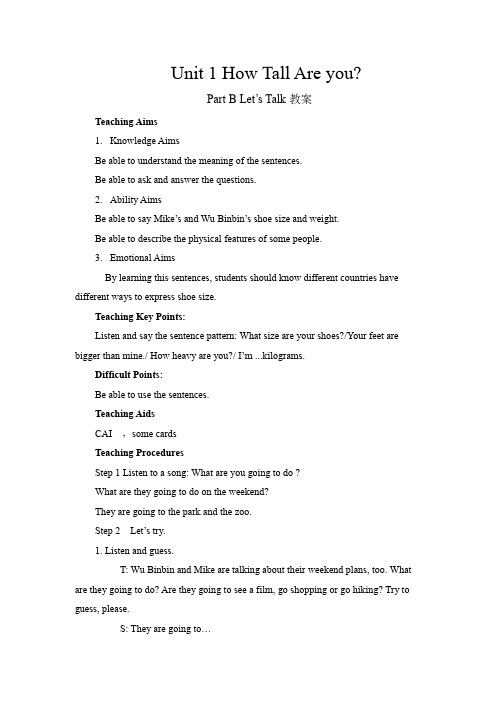
Unit 1 How Tall Are you?Part B Let’s Talk教案Teaching Aims1.Knowledge AimsBe able to understand the meaning of the sentences.Be able to ask and answer the questions.2.Ability AimsBe able to say Mike’s and Wu Binbin’s shoe size and weight.Be able to describe the physical features of some people.3.Emotional AimsBy learning this sentences, students should know different countries have different ways to express shoe size.Teaching Key Points:Listen and say the sentence pattern: What size are your shoes?/Your feet are bigger than mine./ How heavy are you?/ I’m ...kilograms.Difficult Points:Be able to use the sentences.Teaching AidsCAI ,some cardsTeaching ProceduresStep 1 Listen to a song: What are you going to do ?What are they going to do on the weekend?They are going to the park and the zoo.Step 2 Let’s try.1. Listen and guess.T: Wu Binbin and Mike are talking about their weekend plans, too. What are they going to do? Are they going to see a film, go shopping or go hiking? Try to guess, please.S: They are going to…2. Listen and check.T: Wu Binbin and Mike are going to go hiking and go shopping. What do they want to do first, go shopping or go hiking? Listen and circle.S: (Finish) They are going to go shopping first.T: Good. What are they going to buy?S: Hiking clothes and shoes.Step 3. Let’s talk.1 .Look at the pictures.T: Wu Binbin and Mike are in the shoe store now. Please look at their feet. Whose feet are bigger ,Mike’s or Wu Binbin’s?Ss: Mike’s.T: Wonderful! Mike’s feet are bigger than Wu Binbin’s . Wu Binbin’s feet are smaller than Mike’s.2.Learn the language.① Look at the video. Find out Wu Binbin’s and Mike’s shoes .T: Mike’s feet are bigger. Wu Binbin’s feet are smaller. What size are Wu Binbin’s shoes? What size are Mike’s shoes? Whose is bigger?Question 1T: What size are Wu Binbin’s shoes?S: His shoes are size 37.T: What size are Mike’s shoes?S: His shoes are size 7.Show the Picture 2T: Wu Binbin’s shoes are size 37.Mike’s shoes are size 7. Is size 7 big or small?S: It’s small.T: Yes, size 7 is so small .And which is smaller, size 7 or size 37?S: Size 7 is smaller than size 37.T: Good. But please look at their feet. Mike’s feet are bigger.Why?S: The size 7 shoes are from the USA, but the size 37 shoes are from China.T: Wonderful! Different countries have different ways to express shoe size.Please look at(Picture 3) ,the size 7 shoe are from the USA. And what size are they in China?S: They’re from size 40.T: Great. In China Mike’s shoes are size 40. Which is bigger , size 40 or size 37?S: Size 40 is bigger than size 37.T: Wonderful. Size 40 is bigger. Whose feet are bigger?S: Mike’s feet are bigger than Wu Binbin’s.T: Yes. Now boys and girls, let’s listen to Mike.(Point Mike: In China I wear size 38 shoes.) What’s the matter? Why does Mike say size 38? Why doesn’t he say size 40?S: Is there anything wrong with your shoe size table?T: I think there is something wrong with our textbooks.S: Maybe it’s the lady’s shoe size table.T: I’m happy you can express your opinion freely. I think there is something wrong with our textbooks. Maybe we can make it up on the Internet. We also can make a call or write an email to People’s Education Press.① Guessing gameT: We’ve learned Mike’s and Wu Binbin’s shoe size. Do you want to know my shoe size?S: Yes.T: Please guess what size my shoes are.S: Size 39?T: No, my shoes are smaller.S: Size 38?T: Great! I wear size 38 shoes. What size are your shoes?S: I wear size 36 shoes. Your shoes are smaller than mine.① Comparing weight(Picture 4) Mike feet are bigger. What about their weight? How heavy is Mike? How heavy is Wu Binbin? Now, let’s read and match.3.Read after the tape.Read and choose.Act out the dialogue.Let’s say.(Picture 6) .Fill in the blanks.Step 4 .Talk about your friend.T: We have known some information about Wu Binbin and Mike. How much do you know about your classmates? Now, please take out this piece of paper and talk in pairs, please.Fill in the blanks. Describe your friend. Then guess, who is he? Or who is she?Step 5. Homework1.Listen to the tape.2.Students compare and discuss their own physical features.Design boardUnit 1 How Tall Are you?Part B Let’s TalkWhat size are your shoes?My shoes are size 37.How heavy are you?I’m ...kilograms.。
六年级下册英语优质教案-Unit 1 How tall are you?-人教(PEP)版 (4)
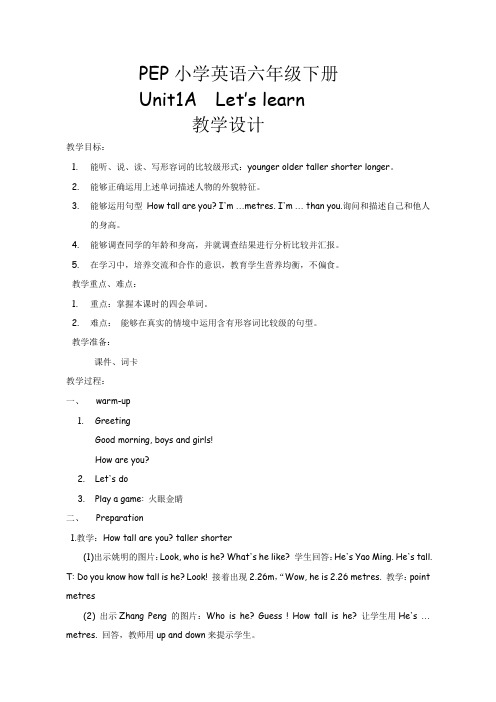
PEP小学英语六年级下册Unit1A Let’s learn教学设计教学目标:1.能听、说、读、写形容词的比较级形式:younger older taller shorter longer。
2.能够正确运用上述单词描述人物的外貌特征。
3.能够运用句型How tall are you? I’m …metres. I’m … than you.询问和描述自己和他人的身高。
4.能够调查同学的年龄和身高,并就调查结果进行分析比较并汇报。
5.在学习中,培养交流和合作的意识,教育学生营养均衡,不偏食。
教学重点、难点:1.重点:掌握本课时的四会单词。
2.难点:能够在真实的情境中运用含有形容词比较级的句型。
教学准备:课件、词卡教学过程:一、warm-up1.GreetingGood morning, boys and girls!How are you?2.Let’s do3.Play a game: 火眼金睛二、Preparation1.教学:How tall are you? taller shorter(1)出示姚明的图片:Look, who is he? What’s he like? 学生回答:He’s Yao Ming. He’s tall. T: Do you know how tall is he? Look! 接着出现2.26m,“Wow, he is 2.26 metres. 教学:point metres(2) 出示Zhang Peng 的图片:Who is he? Guess ! How tall is he? 让学生用He’s …metres. 回答,教师用up and down来提示学生。
(3) T: Zhang Peng is 1.65 metres. I’m 1.61 metres. How tall are you? 引导学生回答:I’m … metres. T: Oh, I’m taller.或者I’m shorter.来比较。
人教pep版小学英语六年级下册英语全册教案
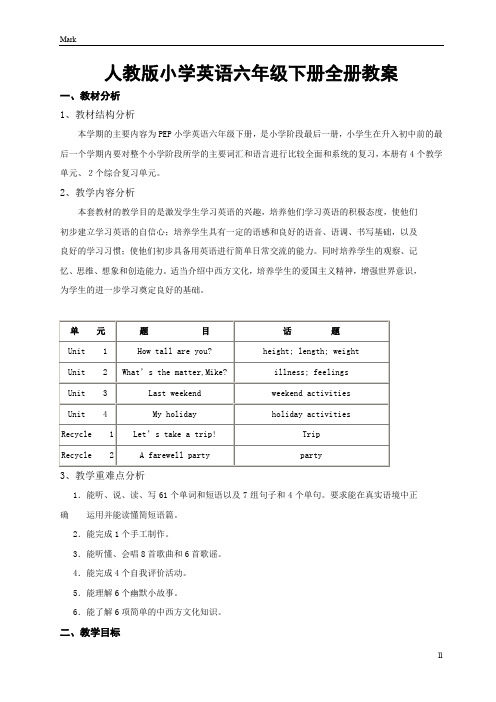
人教版小学英语六年级下册全册教案一、教材分析1、教材结构分析本学期的主要内容为PEP小学英语六年级下册,是小学阶段最后一册,小学生在升入初中前的最后一个学期内要对整个小学阶段所学的主要词汇和语言进行比较全面和系统的复习,本册有4个教学单元、2个综合复习单元。
2、教学内容分析本套教材的教学目的是激发学生学习英语的兴趣,培养他们学习英语的积极态度,使他们初步建立学习英语的自信心;培养学生具有一定的语感和良好的语音、语调、书写基础,以及良好的学习习惯;使他们初步具备用英语进行简单日常交流的能力。
同时培养学生的观察、记忆、思维、想象和创造能力。
适当介绍中西方文化,培养学生的爱国主义精神,增强世界意识,为学生的进一步学习奠定良好的基础。
单元题目话题Unit 1 How tall are you? height; length; weightUnit 2 What’s the matter,Mike? illness; feelingsUnit 3 Last weekend weekend activitiesUnit 4 My holiday holiday activitiesRecycle 1 Let’s take a trip! TripRecycle 2 A farewell party party3、教学重难点分析1.能听、说、读、写61个单词和短语以及7组句子和4个单句。
要求能在真实语境中正确运用并能读懂简短语篇。
2.能完成1个手工制作。
3.能听懂、会唱8首歌曲和6首歌谣。
4.能完成4个自我评价活动。
5.能理解6个幽默小故事。
6.能了解6项简单的中西方文化知识。
二、教学目标本套教材的教学目的是激发学生学习英语的兴趣,培养他们学习英语的积极态度,使他们初步建立学习英语的自信心;培养学生具有一定的语感和良好的语音、语调、书写基础,以及良好的学习习惯;使他们初步具备用英语进行简单日常交流的能力。
同时培养学生的观察、记忆、思维、想象和创造能力。
PEP小学英语六年级下册Unit4单元整体教学设计
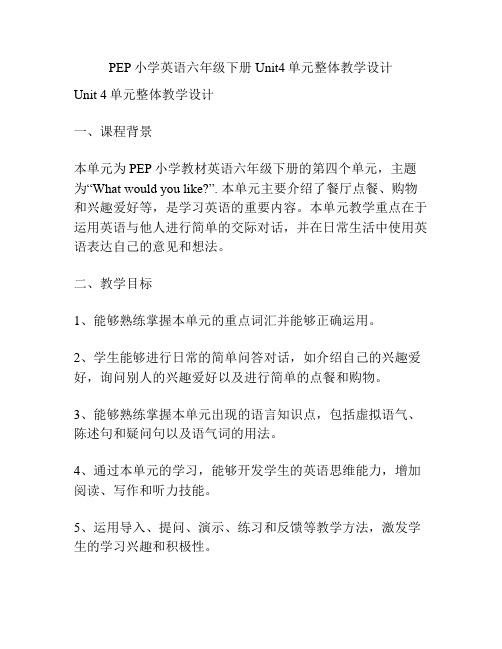
PEP小学英语六年级下册Unit4单元整体教学设计Unit 4单元整体教学设计一、课程背景本单元为PEP小学教材英语六年级下册的第四个单元,主题为“What would you like?”. 本单元主要介绍了餐厅点餐、购物和兴趣爱好等,是学习英语的重要内容。
本单元教学重点在于运用英语与他人进行简单的交际对话,并在日常生活中使用英语表达自己的意见和想法。
二、教学目标1、能够熟练掌握本单元的重点词汇并能够正确运用。
2、学生能够进行日常的简单问答对话,如介绍自己的兴趣爱好,询问别人的兴趣爱好以及进行简单的点餐和购物。
3、能够熟练掌握本单元出现的语言知识点,包括虚拟语气、陈述句和疑问句以及语气词的用法。
4、通过本单元的学习,能够开发学生的英语思维能力,增加阅读、写作和听力技能。
5、运用导入、提问、演示、练习和反馈等教学方法,激发学生的学习兴趣和积极性。
三、教学内容及安排1、New words and expressions.首先,进行新单元单词的学习。
教师可以设计一些语言游戏以及相关的图表,如单词关联图,情境图等,辅助学生更好地学习新单词;还可以根据具体单词,设计一些锻炼学生听、说、读、写能力的活动,例如听说游戏、单字比赛等。
建议在整个学期中将单词提供给学生进行反复练习。
2、What would you like? & Would you like some tea?重点呈现本单元的两个句型,可使用影视书写、动态展示以及小组对话等形式,在实践归纳的基础上帮助学生理解和掌握句型。
共同练习后,通过情境场景将句型的使用进行引入,让学生尝试就“餐厅点餐”、“购物”等真实场景进行练习。
3、Hobbies针对兴趣的讨论,可以在教学一开始进行学生个人的自我介绍,引出兴趣要素的内容,让学生可以通过自我表达发现与自己兴趣相同的同学、激发新的学习乐趣。
针对学生所建立的兴趣爱好,可以设计相关阅读、听力活动,例如小组自编故事、个人朗读等。
PEP人教版小学六年级英语下册教案及教学反思(全册)
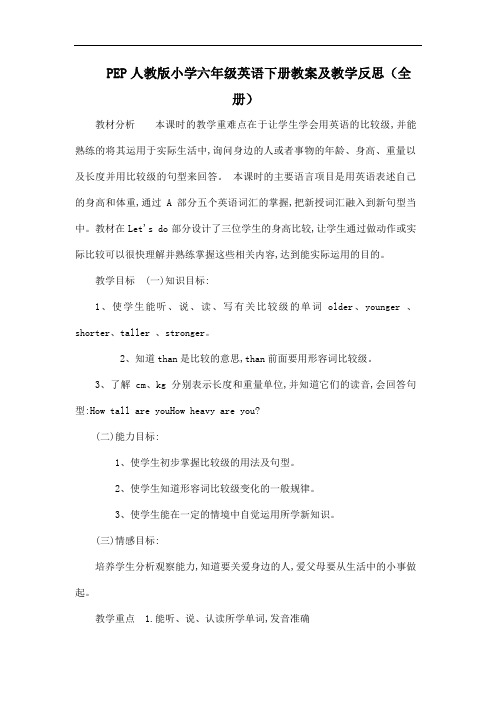
PEP人教版小学六年级英语下册教案及教学反思(全册)教材分析本课时的教学重难点在于让学生学会用英语的比较级,并能熟练的将其运用于实际生活中,询问身边的人或者事物的年龄、身高、重量以及长度并用比较级的句型来回答。
本课时的主要语言项目是用英语表述自己的身高和体重,通过A部分五个英语词汇的掌握,把新授词汇融入到新句型当中。
教材在Let's do部分设计了三位学生的身高比较,让学生通过做动作或实际比较可以很快理解并熟练掌握这些相关内容,达到能实际运用的目的。
教学目标(一)知识目标:1、使学生能听、说、读、写有关比较级的单词older、younger 、shorter、taller 、stronger。
2、知道than是比较的意思,than前面要用形容词比较级。
3、了解cm、kg分别表示长度和重量单位,并知道它们的读音,会回答句型:How tall are youHow heavy are you?(二)能力目标:1、使学生初步掌握比较级的用法及句型。
2、使学生知道形容词比较级变化的一般规律。
3、使学生能在一定的情境中自觉运用所学新知识。
(三)情感目标:培养学生分析观察能力,知道要关爱身边的人,爱父母要从生活中的小事做起。
教学重点 1.能听、说、认读所学单词,发音准确2.能读准than并能运用比较级的句型。
教学难点 1.正确运用形容词的比较级谈论自己和他人的具体情况。
2.能结合实际,用英文的长度和重量单位进行问答。
教学准备课件、图片预设过程设计意图Step 1.Warm-up revision1 Sing a song.What’s your favourite season?2 Free talk.a. What’s your favourite season?Which season is it now?What’s the weather like in winter?Which season is always hot and sunny / warm and rainy?/cool and cloudy?/cold and snowy?b. Which season can we make a snowman , winter or fall?Which season can we go swimming in a river, winter or summer?Which season can we fly kites, winter or spring Which season is colder,summer or winter?Which is colder , water or ice-cream?c. I can say , cold --colderCan you say? warm ---warmer, cool---cooler, hot--- hotter,old ---olderStep2. Presentation practice older/ younger的教学How old is the woman She is 35 2How old is the girlShe is 12.Who’s older, the woman or the girl 43512, so we can say the woman is older than the girl.(出示图片) 12<35. We can say the girl is younger than the woman.Now let’s play a gameGuess:How old am IIf your number is more than my age, I will tell you older. If your number is less than my age , I will tell you younger. Let’s see who can guess quickly.How old am I? Gu ess, guess , guessIt’s my turn now. You should ask me and say older or younger to help me. (出示图片)shorter/ taller的教学1. Look at the fishing rod, it looks very short. In fact it’s long. Let’s have a look. Oh, it’s too long .It’s difficult for me to take it. Now let’s make it shorter and shorter. Everybody should say shorter ,shorter , shorter. Then I’ll let you see it can be shorter and shorter. (出示钓鱼杆)2. Which are shorter, the shorts or the pants?(出示图片)Who’s shorter, Zhang Yining or Yao Ming?(出示图片)H ow tall is Zhang Yining?She’s 168cmHow tall is Yao Ming?He’s 226cm 教学长度单位cmcentimeter3.Who’s taller, Zhang Yining or Yao Ming Which animal is taller, the giraffe or the deer?4.Who’s taller than you?5. How tall is it ?(出示图片170cm,160cm,180cm,150cm)6.How tall are you? Come here.Line up from shorter to taller.Line up from taller to shorter.Let’s do: Shorter, shorter, shorter, make myself shorter.Taller, taller, taller, make myself taller.stronger的教学1. You look strong and tall. I can do it. Can you do it? (老师拉着拉力器说)2. Yes, I can .(请两个学生分别做)3. You look as strong as me. But who is stronger, you or INow, let’s play another game. If you think I’m stronger than her, please come here. If you think she is stronger than me, please go there. Everybody should say stronger , strongerReady, go.4. Who’s stronger, she or I5. Which animal is stronger, the tiger or the elephant? (出示图片)Is a cat stronger than a mouse?I can say a bear is stronger than a squirrel. Who can say like me6. Which animal is stronger, the cock or the ant?How heavy is the cock? It’s about 3kg.教学重量单位的读音Step3. Task time consolidationThe new year is coming. We are older than the last year, we are taller than the last year. We are stronger than the last yearLook , 出示表格:Name Age Height WeightI 27 161cm 54kgMy friend 25 158cm 52kg2From the form above , can you say something about my friend and me is old than , is younger thanis taller than, is shorter than is stronger than 3. Can you say something about you and your best friend?1. Ask your parents and finish the form. Then say something about your parents.Name Age Height WeightFather cm kgMother cm kg is older than is taller thanis stronger than2. Remember these numbers forever. Give your father or mother a surprise on their birthdays创设真实任务活动进行比较, 让学生明确目标 ,带着任务去学习新的知识taller 和than的用法。
最新人教版PEP小学英语六年级下册教案(全册)

最新人教版PEP小学英语六年级下册教案(全册)篇1一、教学目标-知识目标:学生能够掌握人教版PEP 小学英语六年级下册课本中的重点词汇、句型和语法知识。
比如能准确说出“go cycling”“ice-skate”等动词短语,会用“Before, I couldn't... Now, I can...”句型进行表达。
-技能目标:提升学生的听、说、读、写四项基本技能。
学生能听懂简单的英语对话并作出回应,能用英语进行日常交流,能正确朗读课文,能书写规范的英语短文。
-情感目标:激发学生学习英语的兴趣,培养学生的合作精神和自信心。
让学生在学习英语的过程中感受到乐趣,敢于开口说英语。
二、教学重点与难点-教学重点:掌握课本中的重点词汇和句型,能够熟练运用所学知识进行交流。
例如重点词汇“dining hall”“gym”等,重点句型“...years ago, there was/were... Now there is/are...”。
-教学难点:语法知识的理解和运用,如一般过去时和一般现在时的区别。
对于小学生来说,理解时态的变化可能会有一定难度,这就需要通过具体的例子和情景来帮助他们理解。
三、教学方法-情景教学法:创设各种真实的情景,让学生在情景中学习英语。
比如,创设学校场景,让学生用英语介绍学校的变化;创设购物场景,让学生练习购物用语。
-游戏教学法:通过游戏激发学生的学习兴趣。
比如,单词接龙游戏,让学生快速复习所学词汇;角色扮演游戏,让学生分角色表演对话,提高口语表达能力。
-歌曲教学法:教学生唱英语歌曲,既可以活跃课堂气氛,又能帮助学生记忆单词和句型。
比如教学生唱“Apple Round”这首歌,让学生在欢快的旋律中学习英语。
四、教学过程(一)导入师:“同学们,咱们先来听一首好听的英文歌怎么样?这首歌可有趣啦!”(播放英文歌曲《Big Big World》)师:“好听不?这首歌呀,特别有活力。
那同学们,你们从这首歌里听到了哪些单词呀?”生:“world”“big”……师:“非常棒!那今天呢,咱们就一起走进一个充满奇妙英语的大世界。
新人教PEP版小学六年级英语下册Unit1Period1 PartA优质教案
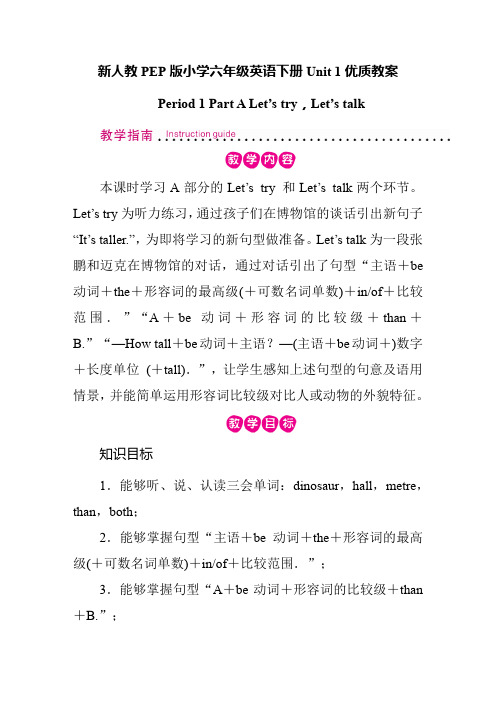
新人教PEP版小学六年级英语下册Unit 1优质教案Period 1 Part A Let’s try,Let’s talk本课时学习A部分的Let’s try 和Let’s talk两个环节。
Let’s try为听力练习,通过孩子们在博物馆的谈话引出新句子“It’s taller.”,为即将学习的新句型做准备。
Let’s talk为一段张鹏和迈克在博物馆的对话,通过对话引出了句型“主语+be 动词+the+形容词的最高级(+可数名词单数)+in/of+比较范围.”“A+be动词+形容词的比较级+than+B.”“—How tall+be动词+主语?—(主语+be动词+)数字+长度单位(+tall).”,让学生感知上述句型的句意及语用情景,并能简单运用形容词比较级对比人或动物的外貌特征。
知识目标1.能够听、说、认读三会单词:dinosaur,hall,metre,than,both;2.能够掌握句型“主语+be动词+the+形容词的最高级(+可数名词单数)+in/of+比较范围.”;3.能够掌握句型“A+be动词+形容词的比较级+than +B.”;4.能够用句型“—How tall+be动词+主语?—(主语+be动词+)数字+长度单位(+tall).”询问人或动物的身高并回答;5.能够独立完成Let’s try的听力练习;6.能够理解Let’s talk的对话内容。
能力目标1.培养学生良好的听力习惯及听力能力;2.培养学生的阅读理解能力。
情感目标教育学生要关心身边的人、事物以及自然界中的其他生物。
教学重点掌握本课时的重点句型并能在实际生活中灵活运用。
教师先带领学生反复朗读对话,理解句子的含义,然后教师归纳句型并举例说明,最后学生分小组操练句型。
教学难点理解形容词比较级并能正确使用。
教师先讲解形容词比较级的含义,帮助学生理解,然后通过实物举例说明,最后让学生与同桌互相比较身高,并借助相关句型说一说,达到灵活运用的目的。
- 1、下载文档前请自行甄别文档内容的完整性,平台不提供额外的编辑、内容补充、找答案等附加服务。
- 2、"仅部分预览"的文档,不可在线预览部分如存在完整性等问题,可反馈申请退款(可完整预览的文档不适用该条件!)。
- 3、如文档侵犯您的权益,请联系客服反馈,我们会尽快为您处理(人工客服工作时间:9:00-18:30)。
P E P小学英语六年级下册英语教案公司内部编号:(GOOD-TMMT-MMUT-UUPTY-UUYY-DTTI-P E P小学英语六年级下册英语教案(全册)Unit 1 How tall are you第一课时一、教学目标与要求:1.能够听、说、读、写形容词的比较形式:taller, stronger, older, younger 和 shorter.2.能够用句型:I’m……cm tall. He/ She’s ……cm tall. 描述自己和他人的身高。
3.能够用句型You’re taller than your brother. I’m older than you. 进行年龄和身高的比较。
4.能够听懂教师的指令,按不同年龄、身高排队,并用所学语言进行表述。
二、教学重、难点分析1.重点是能够听、说、读、写A Let’s learn 部分五个形容词的比较级形式;并能用含有比较级的句型替换关键词进行问答。
2.难点是能够听、说、读、写四会单词;并能根据某一情境使用含有形容词比较级的句型替换关键词进行问答。
长度单位cm的完整形式centimeter的发音也是本课的教学难点。
三、课前准备1.准备主情景图的教学挂图。
2.准备录音机、本课时的录音带。
3.准备A Let’s learn 的单词卡片。
4.准备测量身高和体重的工具。
四、教学步骤1. GreetingsHello, boys and girls . Happy New Year. And nice to see you again.How are you Now, after a term, I thin you know much better about your teachers. Who’s you music teacher What’s he/she like引导学生用学过的形容词thin, short, tall, old, young, funny,strong, kind 来描述这位老师。
当问到学生Who’s your English teacher时,根据学生的回答She’s tall.2.师出示测身高与体重的量器,提问学生:How tall am I , do you know Guess 帮助学生用句型Are you ……cm tall 来猜。
师用up 和down 帮助学生猜出确切的数字。
3.师请出猜中自己身高的学生,问: How tall are you帮助他/她测量身高,引导该学生说:I’m……cm tall。
然后师说:……is taller than me. 或I’m taller than……来结束该游戏。
4.板书测量的学生的身高,师尽量用手势帮助学生理解以下句子:A is tall. B is taller than A. C is taller than B. D is taller than C.然后板书并领读tall-taller 。
5.师请出三名较强壮的学生模仿健美动作,并做比较说:You’re strong.He’s stronger than you.并板书领读strong-stronger6.师在黑板上列出家人的年龄,介绍说:My mother is 44, My father is46. He is older than her. My aunt is younger than my father, butshe is older than my mother. How old is she 然后板书old—older 和young-younger , 让学生回答问题。
7.放Let’s learn部分的录音,学生听录音跟读。
8.Let’s play 师贴出4-5个学生图像,描述各人情况,发指令: Line up from younger to older.Line up from shorter to shorter.9.Let’s chant. 放录音学生跟读。
10.学生做活动手册的配套练习。
第二课时一、教学目标与要求1.能够听、说、读、写四会掌握句子:How tall are you I’m 164cm tall. You’re shorter than me. You’re 4cm taller than me. 并能在情景中正确运用。
2.能够听懂Let’s try 部分的录音并选出正确的选项。
二、教学重难点重点与难点是四会掌握句型:How tall are you I’m 164cm tall.You’re shorter than me. You’re 4cm taller than me.三、课前准备:1.准备录音机和本课时的录音带。
2.准备测量身高和体重的数据。
四、教学步骤1. Warm up2.Let’s chant.3.放Let’s try 部分的录音,学生听录音,圈出录音材料所描述的大象。
4.师:I’m 167cm tall. You’re taller than me. I’m shorter than you. How tall are you该生回答:I’m 168cm tall. 师接着说:Oh, you’re 1cm taller than me.然后板书这组对话并重点领读最后一个句子。
5.师:How old are you, then 生: I’m 14. 师补充:He’s 14 years old. I’m 28 years old. I’m 14 years older than xxx. 再询问几个学生的年龄,并作比较。
6.学生年Let’s talk 部分的对话,师放录音,学生跟读。
7.学生两人一组朗读对话。
8.学生做活动手册的配套练习。
第三课时一、教学目标与要求1.能够听懂、会说Let’s read 部分的对话并完成填充句子的练习,特别是能看懂、会朗读句子:I think the little monkey is only 40cm tall. The monkey is shorter but you are funnier.2.能学唱本单元歌曲。
二、教学重难点1.重点是使学生能够充分理解、正确朗读对话。
2.难点是学生能看懂、会朗读句子: I think the little monkey is only 40cm tall. The monkey is shorter but you are funnier.三、课前准备1.准备录音机和本课时录音带。
2.师准备两张宠物狗的图片。
四、教学步骤1. Warm up跟唱本单元Let’s chant 的歌谣。
学唱本单元歌曲My pets.2.师:The little girl has two pets. What are they 生: A dog and a cat. T: Yes. I have two pets too. Let’s have a look . What are they S: They are dogs.3. T: Yes, I have a black dog and a brown dog. Are they cute Which dog is taller Which dog is stronger学生看图回答。
4. T:The black dog is taller than the brown dog. It’s 80cm tall.The brown dog is 55cm tall. And its tail is longer than than the brown dog. Its tail is about 28cm long. But the brown dog isstronger than the black dog. I like the brown dog. It’s funny.It’s f unnier than the black dog. Which dog do you like5.师再出示一张小猴的图片,说:Look at the monkey. What do think of it 帮助学生回答:It is funny, too.师接着问Which one is funnier, the dog or the monkey 帮助学生表达自己的看法,如:I think themonkey is funnier.6.师引出课文:Ben is watching monkeys at a zoo with his father now. What are the monkeys like Which monkey does Ben like et’s read the dialogue.7.学生听录音,理解对话,完成填充句子练习。
师检查。
8.放录音,学生跟读。
9.学生做活动手册配套练习。
第四课时一、教学目标与要求:1.能够听、说、读、写形容词的比较级形式:heavier, longer, thinner, bigger和smaller.2.能够灵活准确地运用以上形容词比较描述人物和动物的特征差异。
3.能够完成Let’s play部分的活动并在活动中相应的语言正确表达。
4.能够理解story time中的故事。
二、教学重难点1.重点是四会掌握五个形容词的比较形式。
2.难点是掌握以下形容词比较级的构成方式:heavy—heavier, thin—thinner, big—bigger.三、课前准备1.准备录音机、B Let’s learn 和 C Story time 部分的录音带2.准备本课的教学挂图和单词卡片。
3.准备一个汽球,一段弹力皮筋和一组对比明显的人物图片。
四、教学步骤1. Warm up放本单元Let’s chant 录音,学生和着录音吟唱,师与生对话:T: How tall are youS: I’m 160cm tall.T: I’m 168cm tall. You’re shorter than me. You’re 2cm shorter than me.2. 师拿出一个气球,请一名学生帮忙吹,“Please make it big.” 师带领全班学生跟随学生吹气球的节奏喊:Bigger, Bigger, Bigger!呈现该单词。
然后师拿着已经吹大的气球,一点一点放出空气,说: Smaller, Smaller, Smaller!呈现并领读这两个单词。
3.师拿出一段皮筋,一边拉长,一边说:longer, longer, longer! 接着慢慢放松皮筋说:shorter, shorter, shorter!然后呈现并领读这两个单词。
